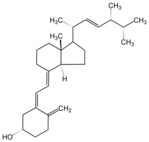Twenty healthy male volunteers were randomly assigned to receive a single 50,000-IU dose of either vitamin D2 (ergocalciferol) or vitamin D3 (cholecalciferol). Similar increases were seen in the serum concentration of the administered vitamins, indicating equivalent absorption. Both treatments also produced similar initial increases in serum 25-hydroxyvitamin D (250HD) concentrations (the assay measured both 250HD2 and 250HD3) over the first 3 days. However, 250HD levels continued to rise in the vitamin D3 group, peaking at 14 days, whereas 250HD levels fell rapidly in the vitamin D2 group and were not different from baseline at 14 days. The area under the serum concentration-time curve (AUC) from day 0 to 28 for vitamin D2 was only 29.4% that for vitamin D3. Calculated AUC (from day 0 to infinity) indicated an even greater differential, with the potency of vitamin D2 being only 10.6% that of vitamin D3.
Comment: Vitamin D3 is the form of vitamin D that occurs naturally in the human body, whereas vitamin D2 is produced by irradiating yeast with ultraviolet light. Since the 1930s, it has been generally assumed that vitamin D3 and vitamin D2 are equally effective in humans. This assumption is based mainly on anti-rachitic bioassays. However, physicians frequently find that oral administration of vitamin D2 in doses of 50,000 IU taken with frequencies ranging from 3 times a week to once every 2 months produces little or no change in serum 25-hydroxyvitamin D (250HD) concentrations. The results of the present study indicate that the potency of vitamin D2 may be as low as 10% that of vitamin D3, and clinical observations suggest that there is considerable individual variation in the response to vitamin D2. Considering that vitamin D3 is the form of vitamin D that occurs naturally in humans, vitamin D3 should be used for routine vitamin D supplementation. On the other hand, patients with hypoparathyroidism or other vitamin D-responsive conditions that are well controlled on high-dose vitamin D2 should probably not have their regimens changed. When changing from vitamin D2 to vitamin D3, it is important to remember the differences in potency, and to monitor serum concentrations of 25-OHD until the optimal dose is achieved.
Armas LAG, et al. Vitamin D2 is much less effective than vitamin D3 in humans. J Clin Endocrinol Metab 2004;89:5387-5391.
COPYRIGHT 2005 The Townsend Letter Group
COPYRIGHT 2005 Gale Group



